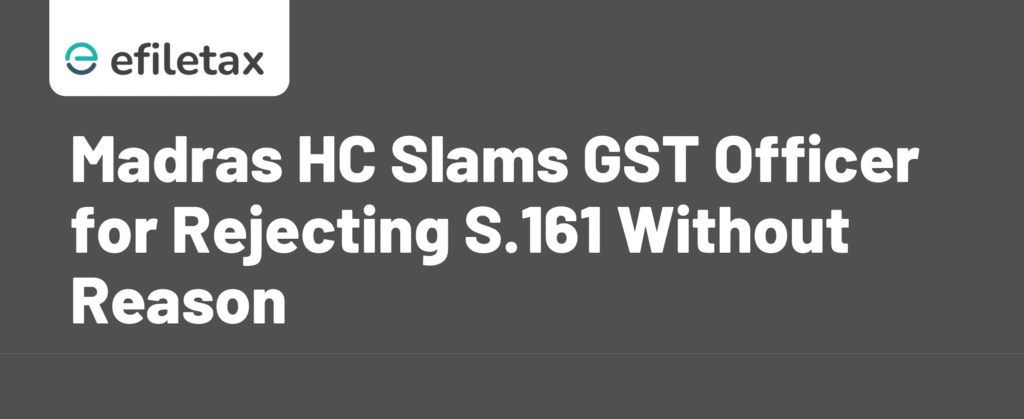
GST Section 161 Rectification What Madras HC’s Ruling Means for Taxpayers
Under GST law, Section 161 of the CGST Act allows rectification of errors in decisions or orders by authorities. But what if your application is dismissed without proper consideration?
This blog breaks down the issue, ruling, and practical takeaway, especially for taxpayers and consultants filing GST rectification applications.
What Is Section 161 of the CGST Act?
Section 161 allows GST officers to rectify any mistake apparent from the record in their orders, notices, or decisions.
- Suo motu by the officer, or
- On application by the taxpayer
Key condition?
The mistake should be apparent from the record — meaning obvious, not debatable or interpretative.
Time Limit:
Rectification must be made within 3 months from the date of the original order.
Case Snapshot: What Happened in the Madras HC?
- Petitioner: Filed a rectification application under Section 161.
- Officer’s Response: Rejected the application with a one-liner — “No apparent error.”
- Court’s View: Such a cryptic order is not legally sustainable.
“A speaking order must disclose reasons for rejection,” observed the Court.
The HC quashed the rejection and directed the officer to reconsider the application afresh with due process.
Legal Takeaways from the Judgment
- Natural Justice Applies: Even rectification applications demand application of mind and fair hearing.
- Taxpayer Rights: If a valid rectification request is rejected vaguely, judicial review is possible.
When Can You Use GST Section 161?
Some examples of “mistake apparent from record” include:
| Example Issue | Rectifiable under S.161? |
|---|---|
| Clerical/Typo errors in name or figures | ✅ Yes |
| Omission of uploaded documents | ✅ Yes |
| Change in interpretation or law | ❌ No |
| Legal disputes or subjective claims | ❌ No |
Expert Tip: How to Strengthen Your GST Rectification Application
“Always attach supporting records and clearly mention the mistake you’re pointing out. Vague or unsubstantiated claims will likely be rejected.”
— CA Prakash Nair, Indirect Tax Expert
Checklist before filing under Section 161:
- Mention exact order number and date
- Highlight the mistake with reference to original record
- Upload supporting invoices, returns, or emails
- File within 3 months from the original order
Legal Reference
- Section 161, CGST Act, 2017
- Madras HC Ruling – W.P. No. — of 2025 (Exact citation awaited)
- CBIC FAQs and Circulars on procedural fairness
Need Help Filing a GST Rectification?
Don’t let errors go uncorrected due to procedural mistakes. At Efiletax, our team helps you draft legally sound rectification applications under Section 161.
Summary
Madras HC quashed a GST officer’s rejection of a Section 161 rectification application for stating “no apparent error” without explanation. The court ruled such orders must provide valid reasoning. Learn how to file a GST rectification properly under Section 161 with expert tips.
FAQs on GST Rectification (S.161)
Q1. Can I file rectification after 3 months?
No. Section 161 mandates that rectification must be made within 3 months of the original order.
Q2. Is hearing mandatory before rejecting my application?
Yes. The officer must pass a reasoned and speaking order, upholding principles of natural justice.
Q3. Can I appeal if my rectification request is rejected?
You can challenge the rejection via writ petition in High Court, especially if rejection lacks reasoning.